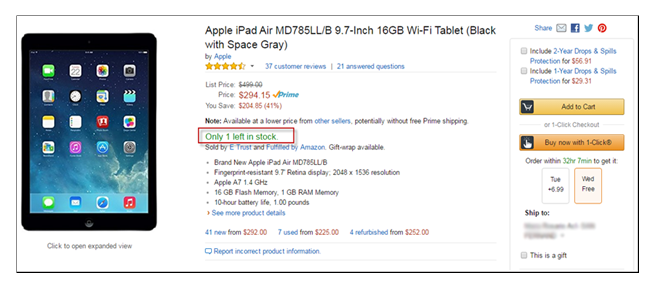Making Product Pages Persuasive with Kahneman's Principles

:: By Martin Greif, EVP of SiteTuners ::
If you're looking for ideas to prime your product pages for conversion, your go-to resource probably isn't going to start off with questions about Gandhi's age. Let's go with that anyway.
Scholars Fritz Strack and Thomas Mussweiler were testing something, and they started doing that by dividing people into two groups, and then asking them at what age Gandhi died. They didn't just ask that question though. They prefaced the question a little bit differently between the two groups:
Group 1: Did he die before or after the age of 9?
Group 2: Did he die before or after the age of 140?
Keep in mind that both of those statements seem, logically, useless. People who are tangentially aware about Gandhi know he lived to be over 9 years old. People generally don't live to be over 130 years old. Rationally, the statements shouldn't influence the guesses about Gandhi's age, but here's what actually happened:
Group 1 Guess: 50
Group 2 Guess: 67
If the first question doesn't have any logical value, then why did it cause a gulf between the responses between group 1 and group 2?
The answer lies in the way our faulty, irrational, short-cut-loving brains work, and its love for anchoring.
Anchoring Psychologist, author and Nobel Prize winner Daniel Kahneman studied the anchoring effect quite a bit. He and Amos Tvesrky once asked two groups of participants to estimate the result of a computation. They were given five seconds to answer one of these two questions:
Group 1: 1 x 2 x 3 x 4 x 5 x 6 x 7 x 8
Group 2: 8 x 7 x 6 x 5 x 4 x 3 x 2 x 1
The answers should be the same, but the participants didn't have time to compute. Here's how they responded:
Group 1 Guess: 512
Group 2 Guess: 2,250
Note the first numbers the participants saw, and then how high their estimates ended up being. The second group's guess is over four times larger than the first group's guess, but keep in mind that the second group started thinking about multiplying 8, 7 and 6, rather than 1, 2 and 3.
That's anchoring at work; we're primed, more than we'd like to admit, by what we see first. What we see first has an incredible amount of impact on how we estimate or perceive value in the things we see. Now hold that thought, and look at this Amazon page for an iPad.

Why is the list price there? $499 has no meaningful impact to the user. It's not what he or she is going to pay for the device. It's not what others are going to pay for the device. The only reason it's there is so visitors can anchor against $499 and make the actual price, $294.15, seem like a steal. It works for Amazon, and it should work for other product pages too.
Prospect Theory and Loss Aversion
Kahneman's Nobel Prize on prospect theory contained the notion of anchoring, but it also included theories about loss aversion, and how people deal with potential gains versus potential losses. Loss aversion would end up being just as important to online marketing as anchoring.
To understand just how powerful this is, think about how you would decide things in these situations.
Scenario 1
You have two options:
+ You can win $940 and have a 100% chance of winning
+ You can win $1,000 and have a 95% chance of winning
In most observed situations, the first option would be the preferred one, despite the second having the higher yield. Did your answer match up with common results? Now, let's switch it up.
Scenario 2
You start with $1,000. You have two options.
+ You can choose a 100% chance to lose $950
+ You can choose a 95% chance to lose $1,000
Those two things are roughly equal for 100 people based on probability (100 percent chance to retain $50, versus five percent chance to retain $1,000). Despite this, most people would choose the second option. So in scenario 1, people would be risk-averse, but in scenario 2, people would tolerate risk because they would be loss-averse.
There are two key principles at play here:
+ Low probabilities are over-considered by people for losses
+ Fear of loss motivates people more than potential for gains
This is why insurance works. Paying a small pre-determined price mentally taxes us less than potentially paying a larger price down the line. We tend to view tiny risks related to losses as larger than they actually are. Now, let's look at that Amazon page again.

Only "1 left in stock" is there to motivate people to act soon. The idea is that the imagined savings are already at risk; that the $204.85 in savings is something the users can lose, if they don't act quickly. That's loss aversion at work.
Making Kahneman's Observations Work for You
Like everything else in online marketing, it's possible to overplay those cards.
+ Making the "anchor"¬ù price larger than the call to action? Probably a bad idea.
+ Making the "stock or time left" on the offer push critical information below the fold? Not going to work.
Still, it pays to understand the underlying mechanisms within our brains. We are nowhere near as logical as we like to think we are, and that affects how online marketing messages reach us. That's the thing a lot of people don't realize; our brains have essentially not changed for thousands of years, but modern life has made it so there are hundreds of complicated decisions we need to make daily. The brain, not being very equipped to deal with this, relies on the one thing it can: shortcuts. Anchoring and loss aversion are very much shortcuts for daily life. The important thing for online marketing is, they are shortcuts that are relatively predictable.
+ Anchoring biases toward the first thing users see, so you can improve perceived value by showing a high figure users will benchmark against.
+ Prospect theory biases toward fear of loss, so you can reframe your message to make users act soon.
If you apply anchoring and loss aversion principles and test away, you're much, much more likely to convince more of your visitors to convert.
Write More Compelling Copy
Learn the tricks of the trade at wsm.co/sellstory.
¬ùMartin Greif brings 25-plus years of sales and marketing experience to SiteTuners, where he is responsible for driving revenue growth, establishing and nurturing partner relationships and creating value for SiteTuners' broad customer base.

Subscribe to Our Newsletter!
Latest in Marketing









